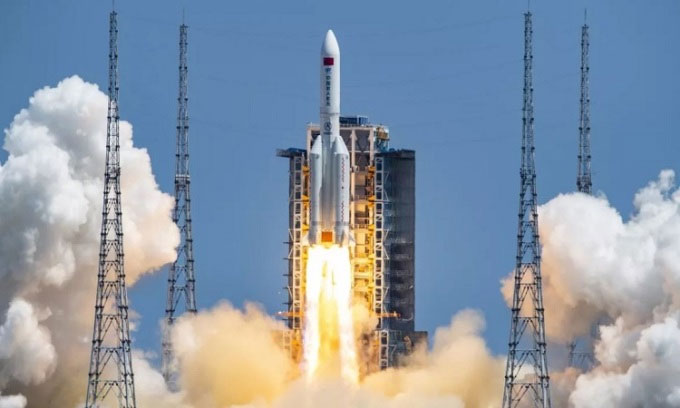Astronomers Predict that Debris from the Long March 5B Rocket Carrying the Wentian Module Will Fall Uncontrolled to Earth.
The Long March 5B rocket was launched on July 24 from the Wenchang Space Launch Site in Hainan Province, carrying the Wentian experimental module powered by solar energy to China’s Tiangong space station. Due to the rocket’s large size, many experts are concerned that instead of burning up in the atmosphere, debris from the first stage will fall to the ground, Newsweek reported on July 25.

Long March 5B rocket launched on July 24. (Photo: Hou Yu)
Typically, after the rocket has used all the fuel in the first stage, this part will separate to reduce weight and fall back to Earth. They usually burn up while hurtling through the atmosphere at high speeds. However, the Long March 5B rocket is exceptionally large, standing nearly 54 meters tall and weighing about 816,500 kg. The first stage of the rocket will break apart, but past experiences indicate that metal debris up to 30 meters long could hit the ground at speeds of several hundred kilometers per hour, according to Jonathan McDowell, an astronomer at the Harvard-Smithsonian Center for Astrophysics.
The larger the spacecraft, the more debris falls through the atmosphere, especially components made from heat-resistant materials. “It’s very difficult to estimate the remaining mass and the amount of debris without knowing the object’s design, but the estimated ratio is about 20 – 40% of the original dry mass,” said Holger Krag, director of the Space Safety Program Office at the European Space Agency (ESA).
The location where the debris will fall is also hard to predict, especially during solar activity, which causes significant fluctuations in the atmosphere, complicating the trajectory modeling. The speed of the descent from orbit depends on the size and density of the object. If the parameters and orbital angle of the rocket are known, researchers can predict the timing and location of the debris falling more accurately.
The likelihood of debris falling on populated areas is very low. NASA estimates the risk of a person being hit by falling space debris is about 1 in 3,200. However, as the amount of space debris in Earth’s orbit increases, the rate of debris falling from the sky also rises, particularly in the Southern Hemisphere. NASA is currently tracking 27,000 small debris pieces in orbit, moving at speeds of up to nearly 25,300 km/h.
Rockets can be designed to re-enter the atmosphere and land in predetermined areas that do not pose a risk to human life or property. Last year, the main stage of a Chinese rocket fell into the Indian Ocean. In 2020, debris including a tube over 12 meters long fell onto two villages in Côte d’Ivoire, destroying several buildings.


















































